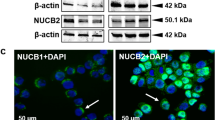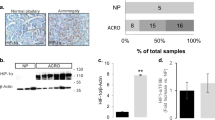Abstract
AMP-activated protein kinase (AMPK) is activated under conditions that deplete cellular ATP and elevate AMP levels such as glucose deprivation and hypoxia. The AMPK system is primarily thought of as a regulator of metabolism and cell proliferation. Little is known about the regulation and the effects of AMPK in somatotroph cells. We present results from “in vitro” studies showing that AMPK activity has a role in regulating somatotroph function in normal rat pituitary and is a promising target for the development of new pharmacological treatments affecting cell proliferation and viability of pituitary adenomatous cells. In parallel, we show “in vivo” data obtained in the rat suggesting that AMPK is an intracellular transducer that may play a role in mediating the effects of the pharmacological treatment with dexamethasone on somatotrophs. In rat pituitary cell cultures, the AMP analog AICAR induced a rapid and clear-cut activation of AMPK. AICAR decreased GH release and total cellular GH content. An appropriate level of AMPK activation was essential for GH3 adenomatous cells. Remarkably, over-activation by AICAR induced apoptosis of GH3 whereas the AMPK inhibitor compound C was more effective at reducing cell proliferation. The role of endocrine or paracrine factors in regulating AMPK phosphorylation and activity in GH3 cells has been also studied. As to “in vivo” studies, western blot analysis revealed a significant decrease of phosphorylated AMPK alpha-subunit in pituitary homogenates of DEX-treated rats versus controls, suggesting reduced AMPK activity. In conclusion, our studies showed that AMPK has a role in regulating somatotroph function in normal rat pituitary and proliferation of pituitary adenomatous cells.







Similar content being viewed by others
References
Tomas E, Tsao TS, Saha AK, Murrey HE, Zhang Cc C, Itani SI, Lodish HF, Ruderman NB (2002) Enhanced muscle fat oxidation and glucose transport by ACRP30 globular domain: acetyl-CoA carboxylase inhibition and AMP-activated protein kinase activation. Proc Natl Acad Sci USA 99:16309–16313
Lim CT, Kola B, Korbonits M (2009) AMPK as a mediator of hormonal signalling. J Mol Endocrinol 44:87–97
Hawley SA, Boudeau J, Reid JL, Mustard KJ, Udd L, Mäkelä TP, Alessi DR, Hardie DG (2003) Complexes between the LKB1 tumor suppressor, STRAD alpha/beta and MO25 alpha/beta are upstream kinases in the AMP-activated protein kinase cascade. J Biol 2:28
Woods A, Johnstone SR, Dickerson K, Leiper FC, Fryer LG, Neumann D, Schlattner U, Wallimann T, Carlson M, Carling D (2003) LKB1 is the upstream kinase in the AMP-activated protein kinase cascade. Curr Biol 13:2004–2008
Hurley RL, Anderson KA, Franzone JM, Kemp BE, Means AR, Witters LA (2005) The Ca2+/calmoldulin-dependent protein kinase kinases are AMP-activated protein kinase kinases. J Biol Chem 280:29060–29066
Winder WW, Hardie DG (1996) Inactivation of acetyl-CoA carboxylase and activation of AMP-activated protein kinase in muscle during exercise. Am J Physiol 270:E299–E304
Young ME, Radda GK, Leighton B (1996) Activation of glycogen phosphorylase and glycogenolysis in rat skeletal muscle by AICAR–an activator of AMP-activated protein kinase. FEBS Lett 382:43–47
Towler MC, Hardie GD (2007) AMP-activated protein kinase in metabolic control and insulin signaling. Circ Res 100:328–341
Steinberg GR, Jorgensen SB (2007) The AMP-activated protein kinase: role in regulation of skeletal muscle metabolism and insulin sensitivity. Mini Rev Med Chem 7:521–528
Locatelli V, Torsello A (2005) Pyruvate and satiety: can we fool the brain? Endocrinology 146:1–2
Josie M, Evans M (2005) Metformin and reduced risk of cancer in diabetic patients. BMJ 330:1304–1305
Motoshima H, Goldstein BJ, Igata M, Araki E (2006) AMPK and cell proliferation–AMPK as a therapeutic target for atherosclerosis and cancer. J Physiol 574:63–71
Zakikhani M, Dowling R, Fantus IG, Sonenberg N, Pollak M (2006) Metformin is an AMP kinase-dependent growth inhibitor for breast cancer cells. Cancer Res 66:10269–10273
Sengupta TK, Leclerc GM, Hsieh-Kinser TT, Leclerc GJ, Singh I, Barredo JC (2007) Cytotoxic effect of 5-aminoimidazole-4-carboxamide-1-beta-4-ribofuranoside (AICAR) on childhood acute lymphoblastic leukemia (ALL) cells: implication for targeted therapy. Mol Cancer 6:46–58
Buzzai M, Jones RG, Amaravadi RK, Lum JJ, DeBerardinis RJ, Zhao F, Villet B, Thompson CB (2007) Systemic treatment with the antidiabetic drug metformin selectively impairs p53-deficient tumor cell growth. Cancer Res 67:6745–6752
Park HU, Suy S, Danner M, Dailey V, Zhang Y, Li H, Hyduke DR, Collins BT, Gagnon G, Kallakury B, Kumar D, Brown ML, Fornace A, Dritschilo A, Collins SP (2009) AMP-activated protein kinase promotes human prostate cancer cell growth and survival. Mol Cancer Ther 8:733–741
Corton JM, Gillespie JG, Hawley SA, Hardie DG (1995) 5-Aminoimidazole-4-carboxamide ribonucleoside: a specific method for activating AMP-activated protein kinase in intact cells? Eur J Biochem 229:558–565
Rattan R, Giri S, Singh AK, Singh I (2005) 5-Aminoimidazole-4-carboxamide-1-beta-D-ribofuranoside inhibits cancer cell proliferation in vitro and in vivo via AMP-activated protein kinase. J Biol Chem 280:39582–39593
Gao Y, Zhou Y, Xu A, Wu D (2008) Effects of an AMP-activated protein kinase inhibitor, compound C, on adipogenic differentiation of 3T3–L1 cells. Biol Pharm Bull 31:1716–1722
Kanazawa I, Yamaguchi T, Yano S, Yamauchi M, Sugimoto T (2009) Activation of AMP kinase and inhibition of Rho kinase induce the mineralization of osteoblastic MC3T3E1 cells through endothelial NOS and BMP-2 expression. Am J Physiol Endocrinol Metab 296:139–146
Iwasaki Y, Nishiyama M, Taguchi T, Kambayashi M, Asai M, Yoshida M, Nigawara T, Hashimoto K (2007) Activation of AMP-activated protein kinase stimulates proopiomelanocortin gene transcription in AtT20 corticotroph cells. Am J Physiol Endocrinol Metab 292:E1899–E1905
Lu M, Tang Q, Olefsky JM, Mellon PL, Webster NJ (2008) Adiponectin activates adenosine monophosphate-activated protein kinase and decreases luteinizing hormone secretion in LβT2 gonadotropes. Mol Endocrinol 22:760–771
Müller EE, Locatelli V, Cocchi D (1999) Neuroendocrine control of growth hormone secretion. Physiol Rev 79:511–607
Tulipano G, Soldi D, Bagnasco M, Culler MD, Taylor JE, Cocchi D, Giustina A (2002) Characterization of new selective somatostatin receptor subtype-2 (sst2) antagonists, BIM-23627 and BIM-23454. Effects of BIM-23627 on GH release in anesthetized male rats after short-term high-dose dexamethasone treatment. Endocrinology 143:1218–1224
Miller M, Chen S, Woodliff J, Kansra S (2008) Curcumin (deferuloylmethane) inhibits cell proliferation, induces apoptosis, and decreases hormone levels and secretion in pituitary tumor cells. Endocrinology 149:4158–4167
Conejo R, Lorenzo M (2001) Insulin signaling leading to proliferation, survival and membrane ruffling in C2C12 myoblats. J Cell Physiol 187:96–108
Tulipano G, Spano PF, Cocchi D (2008) Effects of olanzapine on glucose transport, proliferation and survival in C2C12 myoblasts. Mol Cell Endocrinol 292:42–49
Girnita L, Wang M, Xie Y, Nilsson G, Dricu A, Wejde J, Larsson O (2000) Inhibition of N-linked glycosylation downregulates insulin-like growth factor-1 receptor at the cell surface and kills Ewing-’s sarcoma cells: therapeutic implications. Anticancer Drug Des 15:67–72
Suzuki A, Kusakai G, Kishimoto A, Shimojo Y, Ogura T, Lavin MF, Esumi H (2004) IGF-1 phosphorylates AMPK-alpha subunit in ATM-dependent and LKB1-independent manner. Biochem Biophys Res Commun 324:986–992
Wehrenberg WB, Bergman PJ, Stagg L, Ndon J, Giustina A (1990) Glucocorticoid inhibition of growth in rats: partial reversal with somatostatin antibodies. Endocrinology 127:2705–2708
Tulipano G, Rossi E, Culler MD, Taylor JE, Bonadonna S, Locatelli V, Cocchi D, Giustina A (2005) The somatostatin subtype-2 receptor antagonist, BIM-23627, improves the catabolic effects induced by long-term glucocorticoid treatment in the rat. Regul Pept 125:85–92
Tulipano G, Taylor JE, Halem HA, Datta R, Dong JZ, Culler MD, Bianchi I, Cocchi D, Giustina A (2007) Glucocorticoid inhibition of growth in rats: partial reversal with the full-length ghrelin analog BIM-28125. Pituitary 10:267–274
Giustina A, Veldhuis JD (1998) Pathophysiology of the neuroregulation of growth hormone secretion in experimental animals and the human. Endocr Rev 19:717–797
Davies SP, Helps NR, Cohen PT, Hardie DG (1995) 5′-AMP inhibits dephosphorylation, as well as promoting phosphorylation, of the AMP-activated protein kinase. Studies using bacterially expressed human protein phosphatase-2C{alpha} and native bovine protein phosphatase-2AC. FEBS Lett 377:421–425
Christ-Crain M, Kola B, Lolli F, Fekete C, Seboek D, Wittmann G, Feltrin D, Igreja SC, Ajodha S, Harvey-White J, Kunos G, Müller B, Pralong F, Aubert G, Arnaldi G, Giacchetti G, Boscaro M, Grossman AB, Korbonits M (2008) AMP-activated protein kinase mediates glucocorticoid-induced metabolic changes: a novel mechanism in Cushing’s syndrome. FASEB J 22:1673–1683
Pollak M (2008) Insulin and insulin-like growth factor signalling in neoplasia. Nature Rev/Cancer 8:915–928
Yamasaki H, Prager D, Gebremedhin S, Moise L, Melmed S (1991) Binding and action of insulin-like growth factor-1 in pituitary tumor cells. Endocrinology 128:857–862
Ceda GP, Fielder PJ, Donovan SM, Rosenfeld RG, Hoffman AR (1992) Regulation of insulin-like growth factor binding protein expression by thyroid hormone in rat GH3 pituitary tumor cells. Endocrinology 130:1483–1489
Castillo AI, Aranda A (1997) Differential regulation of pituitary specific gene expression by insulin-like growth factor-1 in rat pituitary GH4C1 and GH3 cells. Endocrinology 138:5442–5451
Wang L, Yang H, Adamo ML (2000) Glucose stravation reduces IGF-1 mRNA in tumor cells: evidence for an effect on mRNA stability. Biochem Biophys Res Comm 269:336–346
Zhou G, Myers R, Li Y, Chen Y, Shen X, Fenyk-Melody J, Wu M, Ventre J, Doebber T, Fujii N, Musi N, Hirshman MF, Goodyear LJ, Moller DE (2001) Role of AMPK-activated protein kinase in mechanism of metformin action. J Clin Invest 108:1167–1174
Melmed S, Colao A, Barkan A, Molitch M, Grossman AB, Kleinberg D, Clemmons D, Chanson P, Laws E, Schlechte J, Vance ML, Ho K, Giustina A (2009) Guidelines for acromegaly management: an update. J Clin Endocrinol Metab 94:1509–1517
Giustina A, Chanson P, Bronstein MD, Klibanski A, Lamberts SW, Casanueva PP, Trainer P, Ghigo E, Ho K, Melmed S (2010) A consensus on criteria for cure of acromegaly. J Clin Endocrinol Metab 95:3141–3148
Acknowledgments
This work was supported by grants (ex 60% 2007–2008) from the University of Brescia to G.T. and D.C. and a grant from Novartis Farma SpA to G.T (Italy).
Conflict of interest
M.G., D.C., V.S. have nothing to disclose. M.S. is employed by Novartis Farma SpA (Origgio, Italy). G.T. has received a research grant from Novartis in 2009. A. G. has received consulting and lecture fees from Novartis, Ipsen and Pfeizer.
Author information
Authors and Affiliations
Corresponding author
Rights and permissions
About this article
Cite this article
Tulipano, G., Giovannini, M., Spinello, M. et al. AMP-activated protein kinase regulates normal rat somatotroph cell function and growth of rat pituitary adenomatous cells. Pituitary 14, 242–252 (2011). https://doi.org/10.1007/s11102-010-0288-6
Published:
Issue Date:
DOI: https://doi.org/10.1007/s11102-010-0288-6




